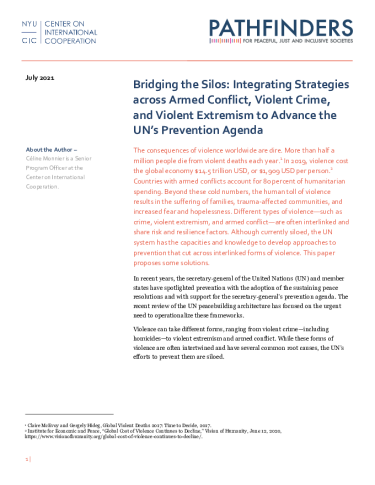The consequences of violence worldwide are dire. More than half a million people die from violent deaths each year. In 2019, violence cost the global economy $14.5 trillion USD, or $1,909 USD per person. Countries with armed conflicts account for 80 percent of humanitarian spending. Beyond these cold numbers, the human toll of violence results in the suffering of families, trauma-affected communities, and increased fear and hopelessness. Different types of violence—such as crime, violent extremism, and armed conflict—are often interlinked and share risk and resilience factors. Although currently siloed, the UN system has the capacities and knowledge to develop approaches to prevention that cut across interlinked forms of violence.

This policy paper makes the argument that the UN can and should adopt a more integrated violence prevention strategy across these three forms of violence. It draws from desk review of UN and academic documents, interviews with UN staff working on different types of violence prevention across the UN system, and a workshop among them. The paper discusses why there is a need for more integrated prevention approaches across different types of violence, what benefits that would bring, and what challenges need to be overcome first. It concludes by making four recommendations: governments should use the SDG 16.1 framework to bring actors together at national level; member states should ask the UN to develop evidence-based guidelines on prevention for countries to implement themselves; the UN should initiate a strategic dialogue at headquarters between fields to better identify commonalities in approaches; and country teams should develop an integrated strategy with specialized sub-strategies.
Read the full brief: Bridging the Silos: Integrating Strategies across Armed Conflict, Violent Crime, and Violent Extremism to Advance the UN’s Prevention Agenda


